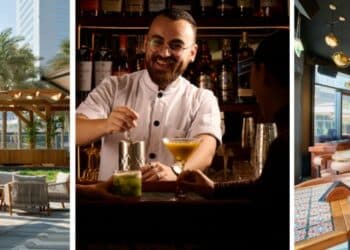With fast emerging foodie-hubs unraveling across Dubai, Hotel News ME talks to the experts to hear how hotel restaurants are biting back with new cutting-edge concepts and building brands inside a hotel to fend off the competition from standalone enterprises.
Today’s F&B marketplace plays host to cut-throat competition with new foodie hubs and concepts popping up across Dubai faster than ever before. Diners are looking for unique products of the finest quality possible complemented by a reasonable price. With styled canteens and standalones vastly emerging, hotels are having to create a necessary edge to compete with brute-force marketing campaigns, new menus and eclectic mixes.
The F&B sector has recently morphed into a hotbed of gastro-mixes, and this can be traced, in part to new trends with the consumer faction constantly growing to include a younger generation that is a lot more conscious about their diets, fitness levels and overall health. According to Nielsen’s latest ‘Global Health and Wellness Survey’, 83% of UAE-based respondents said they were willing to pay a premium for foods with healthy attributes.

In the Gulf, with its significant food imports, the fresh food trend presents a particular opportunity for F&B manufacturers. With the rise in availability of regionally grown or produced food products, fresh food is finally becoming an option for consumers. On the same note, consumers have become much more aware of what they are eating, with an increasing interest in organic and natural foods.
From a manufacturing standpoint this is also presenting new challenges with fresh foods requiring different equipment types and handling processes to be set up and operated.
A growing population base, affluence and rising tourist inflow within the GCC are some of the major factors fueling demand on the F&B industry. Backed by macroeconomic drivers, food consumption is expected to grow at a 3.5% by 2019.
Incidentally, tourist arrivals are expected to go up as well at an annual average growth of 7.8% by 2024, adding to the demand for food and especially the dining out trend. In fact, Dubai alone is set to draw over 25 million visitors during the Expo 2020’s six-month run in addition to the projected annual international visitor traffic of 20 million by 2020.
With the increase in stand-alone restaurants building ‘foodie-hubs’ in areas such as DIFC and Downtown, how has this rise impacted F&B outlets in hotels?
Marti: Dubai has grown into a competitive foodie district with bustling new concepts appearing all over the city. But what standalone restaurants do not have, is the faithful following of guests signed up on loyalty schemes with a brand they already trust. Yes, hotels need to remain innovate, but the rise of standalones has not impacted F&B outlets in hotels in a negative way at all.
Marie: With more alternative options and competition in the market it has become very important for us to focus on what differentiates us from standalones. Some of our key advantages for being in a hotel are: Consistency of our products and experiences; Quality of our food and dining experience; Capturing the right concept that works for the local community and sticking to it, plus in-house guests are spoilt for choice within the hotel.
“Hotels tend to play it safe. They prefer to let the standalone restaurants take the risks and stick to providing a more sanitised dining experience” – Tracey
Krisko: I think standalones have greatly impacted hotel outlets and the F&B scene has become extremely competitive. In the past Michelin Star chefs were only in hotels, but now you have celebrity chefs going it alone, not only that, previously you’d need to be in a hotel to have an alcoholic beverage, but standalones are now able to serve grape alongside their meals too.

Mueller: Luckily this hasn’t affected our outlets because of our strong F&B concepts and our loyalty programme that rewards guests who dine and stay with any Rotana hotels. This gives diners an incentive to return – something stand-alone restaurants don’t offer. Additionally, the price range of eating at a hotel and at a stand-alone restaurant is relatively similar so overall, guests will still examine the perceived value for what they get against what they pay for.
Ataya: Our food and beverage outlets attract a different kind of guest. For example, The Address Dubai Mall is immensely successful in attracting guests from across the GCC – particularly Qatar, Bahrain and Saudi Arabia; so we feel it is vital to offer and produce Arabic favourites to stay competitive.
In your opinion, is it harder for hotel restaurants to create their own identity?
Marti: Every hotel has the capacity to create its own dining identity. Nowadays, we need to think outside of the box, but often where hotels go wrong is that they are stuck in their ways and carry too many brand standards which can sometimes put diners off. We need to work on creating relaxed environments with an ambience reflective of a concept in our hotel restaurants.
Tracey: Hotels tend to play it safe. They prefer to let the stand alone restaurants take the risks and stick to providing a more sanitised dining experience. Hotels have to work hard to create identity and convince customers they are an exciting food destination. You are battling against negative perceptions of hotel dining and the ever changing landscape of F&B industry.

Marie: I do not believe so because if you know the concept and the direction you want to go, then you’ve already started to create your own identity. Also market conditions plays a major role in the success of a venture, so conducting surveys and market research beforehand is very important.
Krisko: Yes – as most customers tend to look at the name of the hotel first before looking at the restaurant. If the hotel does not have a good reputation, it is extremely hard to attract your own clientele into a restaurant within the establishment.
Ataya: If hotels have fresh, innovative ideas with diverse menus that appeal to a sophisticated guest demographic, then creating and maintaining an identity is achievable. Further, using the best tools and creating an attractive ambience in F&B outlets are both key elements for success.
Mueller: I don’t believe it is harder – if the hotel successfully develops the concept and markets it well, the restaurant’s identity will organically form.
How difficult is it to find, train and retain chefs in the UAE?
Ataya: We have a long and established history at The Address Dubai Mall for training and nurturing promising talent. I believe strongly in identifying upcoming chefs from a relatively young age and mentoring and working with them to fulfil their potential.

Marti: It’s all about taking care of people. Chefs, like any other professionals, want to take ownership. They want credit for their work, and often micromanaging chefs doesn’t work. At Grand Hyatt we help our associates be their best. And what do they need for that? A bit of freedom and the sentiment of being appreciated.
Krisko: Retaining staff is tough with the amount of new hotels and restaurants opening. Chefs are often poached and tempted to leave with the promise of an increased salary by competitors. There is less brand loyalty here compared to what you find in Europe and the U.S.
Mueller: Being part of a large company, we have an established learning and development programme with a dedicated team of trainers. We also receive quantifiable feedback from our guests which shows us areas where re-training and re-education may be required. There is also ample opportunity for cross-exposure between sister properties which gives our team a chance to expand their skillset.
Tracey: We are very lucky to have a great team of chefs, many whom have been with us for five years plus. We have invested in training and development, promoting from within and ensuring that our people are ready for the next step before they take it. One of the biggest challenges in the UAE is over promotion. A chef’s desire to progress is usually financially driven and the result is that you have CDP’s and sous chefs who don’t have the ability to effectively do the level of role they have been given.
There have been recent reports of an increase in F&B supply costs, have you experienced this, and how does it impact your operations?
Krisko: Yes, I have definitely noticed a big increase in the price of electricity and water has increased, it is costing more to run the restaurants. Suppliers increase their prices to compensate for the extra import charges too, but restaurant customers want the price of the meal to stay the same. Customers are very aware of prices and if you increase something on the menu by just a very small amount, they will often complain and ultimately start going somewhere else.

Tracey: Yes, we have seen an increase in product costs but we have worked hard to ensure that this doesn’t affect the quality of what we serve to our customers. We are in the process of reducing the number of suppliers we use, developing better relationships with existing ones to help control costs.
Marti: Prices are increasing, and products are becoming more expensive, but it’s all about coordinating with suppliers to see who has the best price without compromising on the quality.
Ataya: Prices of ingredients are always fluctuating, but there are many suppliers in this market, which creates competition, so there are always other options for sourcing ingredients.
Mueller: This is on the contrary for us. We are now seeing better offers for products and lower rates because suppliers want to retain their market share. They seem to prefer adjusting their margins in order not to lose their share of customers.
For instance, we are now seeing a wave of Spanish products, including cheese, meats and vegetables like Padron Peppers coming in because the number of Spanish restaurants opening up has significantly increased. We have streamlined our list of suppliers in order to consolidate our orders and build stronger partnerships.

Marie: Yes, the cost food supplies has increased and this is due to the shortage of supplies in the market. Meat cuts went up as a result of the devaluation of the Euro, so hotels are now forced to look for alternatives without compromising on quality.
Has there been a surge in price in any products that come to mind? If so, why has this happened?
Marti: I have noticed a big increase in the price of meat and seafood and this is certainly related to increasing demand and import fees.
Krisko: U.S beef. With the oil prices currently going down, you would think it would be cheaper to transport it!
Tracey: U.S meat prices have increased significantly recently due to lack of availability. That has forced us to look at other countries to get the same quality at a price we want to pay. We are now using New Zealand reserve beef on our menus and have received great feedback from our customers.


































































